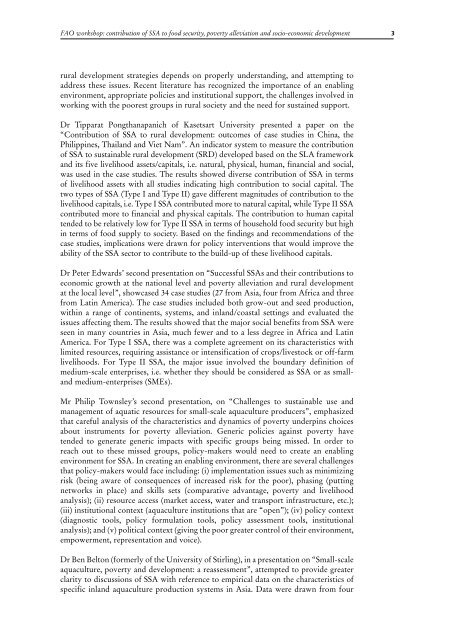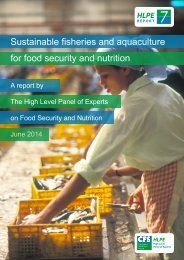BNZ6d
BNZ6d
BNZ6d
Create successful ePaper yourself
Turn your PDF publications into a flip-book with our unique Google optimized e-Paper software.
FAO workshop: contribution of SSA to food security, poverty alleviation and socio-economic development3rural development strategies depends on properly understanding, and attempting toaddress these issues. Recent literature has recognized the importance of an enablingenvironment, appropriate policies and institutional support, the challenges involved inworking with the poorest groups in rural society and the need for sustained support.Dr Tipparat Pongthanapanich of Kasetsart University presented a paper on the“Contribution of SSA to rural development: outcomes of case studies in China, thePhilippines, Thailand and Viet Nam”. An indicator system to measure the contributionof SSA to sustainable rural development (SRD) developed based on the SLA frameworkand its five livelihood assets/capitals, i.e. natural, physical, human, financial and social,was used in the case studies. The results showed diverse contribution of SSA in termsof livelihood assets with all studies indicating high contribution to social capital. Thetwo types of SSA (Type I and Type II) gave different magnitudes of contribution to thelivelihood capitals, i.e. Type I SSA contributed more to natural capital, while Type II SSAcontributed more to financial and physical capitals. The contribution to human capitaltended to be relatively low for Type II SSA in terms of household food security but highin terms of food supply to society. Based on the findings and recommendations of thecase studies, implications were drawn for policy interventions that would improve theability of the SSA sector to contribute to the build-up of these livelihood capitals.Dr Peter Edwards’ second presentation on “Successful SSAs and their contributions toeconomic growth at the national level and poverty alleviation and rural developmentat the local level”, showcased 34 case studies (27 from Asia, four from Africa and threefrom Latin America). The case studies included both grow-out and seed production,within a range of continents, systems, and inland/coastal settings and evaluated theissues affecting them. The results showed that the major social benefits from SSA wereseen in many countries in Asia, much fewer and to a less degree in Africa and LatinAmerica. For Type I SSA, there was a complete agreement on its characteristics withlimited resources, requiring assistance or intensification of crops/livestock or off-farmlivelihoods. For Type II SSA, the major issue involved the boundary definition ofmedium-scale enterprises, i.e. whether they should be considered as SSA or as smallandmedium-enterprises (SMEs).Mr Philip Townsley’s second presentation, on “Challenges to sustainable use andmanagement of aquatic resources for small-scale aquaculture producers”, emphasizedthat careful analysis of the characteristics and dynamics of poverty underpins choicesabout instruments for poverty alleviation. Generic policies against poverty havetended to generate generic impacts with specific groups being missed. In order toreach out to these missed groups, policy-makers would need to create an enablingenvironment for SSA. In creating an enabling environment, there are several challengesthat policy-makers would face including: (i) implementation issues such as minimizingrisk (being aware of consequences of increased risk for the poor), phasing (puttingnetworks in place) and skills sets (comparative advantage, poverty and livelihoodanalysis); (ii) resource access (market access, water and transport infrastructure, etc.);(iii) institutional context (aquaculture institutions that are “open”); (iv) policy context(diagnostic tools, policy formulation tools, policy assessment tools, institutionalanalysis); and (v) political context (giving the poor greater control of their environment,empowerment, representation and voice).Dr Ben Belton (formerly of the University of Stirling), in a presentation on “Small-scaleaquaculture, poverty and development: a reassessment”, attempted to provide greaterclarity to discussions of SSA with reference to empirical data on the characteristics ofspecific inland aquaculture production systems in Asia. Data were drawn from four



